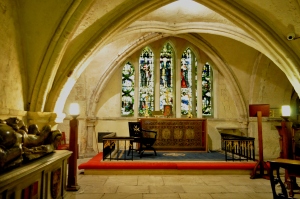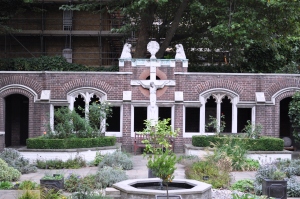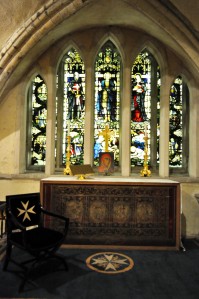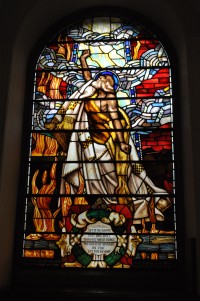Where am I?
If you look carefully in this picture you’ll see some clues. Yes, its a church, although the vaulted ceilings and the tomb may indicate that it is in fact a crypt.
Perhaps you recognise this symbol on the chair by the altar.
Yes, its the cross of St John’s Ambulance or in fact of the Order of St John. The Order had its origins in 11th Century Jerusalem when in 1080 it founded a hospital to look after sick pilgrims. By 1113 the religious Order was registered with the Church as the Order of Hospitallers. After the Crusades it took on a more military focus and its members became know as the Knight of the Order of St John of Jerusalem.
This crypt dates back to the 1140’s but its not in Jerusalem; it’s one of London’s historic treasures situated in St John’s Square in Clerkenwell and was the London Headquarters of the Order.
When King Henry VIII split from the Catholic Church and established the Anglican Church, the Order in England was dissolved and all its lands and wealth were seized by the Crown. The Order was briefly restored by Henry’s Catholic daughter, Queen Mary, who granted it a Royal Charter. However, with the reign of Queen Elizabeth I, the Order in England was dissolved for good.
This tomb dates back to the 16th century. However, the buildings in Clerkenwell were put to different uses in the years that followed. They were used as the offices of the Master of the Revels. Thirty of Shakespeare’s plays were licensed here. However, they quickly reverted back to religious use as a chapel and in the early eighteenth century, a Presbyterian meeting house. In 1721 it was rebuilt giving it much the appearance it has today.
The church became the parish church of St John for some years until 1921 when it was given to the new order of St John of Jerusalem who use it as their chapel. The new Order of St John in England had been granted a Royal Charter by Queen Victoria in 1888. Humanitarian in its aims and purpose, it recognised the need for public First Aid and ambulance transport services, as no such system existed in newly industrialised England. In addition, the Order established an eye hospital in Jerusalem, following the principles of the Order’s first hospital, treating all those in need regardless of faith or wealth.
During the Second World War the church was badly bombed, by the end of the war it was left a blackened shell. The Order of St John restored and rebuilt the church afterwards, although not to original designs.
The new church building is not amazing but there is a cloister garden built in the 1950’s.
However the crypt itself is spectacular and not to be missed.
So if you are in London and looking for ‘free things to do’, don’t miss the peace, tranquility and history of this Christian place of worship. Nearby you can also visit the Museum of the Order of St John (another freebie).
Reviews available on Trip Advisor.
Related articles
- London: Museum of the Order of St. John (divertingjourneys.wordpress.com)
- The Knights of the Order of Saint John & their London Museum (londonunveiled.com)
- Hard-hitting: St John Ambulance shocks with new first aid campaign ‘Save the boy’ (metro.co.uk)













